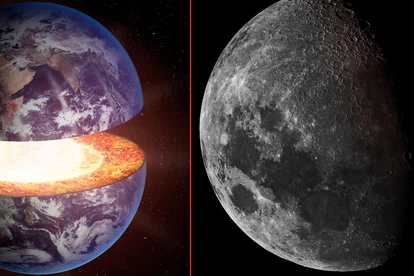The verdict is in, and it appears the Moon is not composed of green cheese, as the age-old saying humorously suggested. An extensive investigation published in May has yielded intriguing insights into the Moon’s composition. It turns out that the inner core of the Moon is a solid sphere with a density similar to that of iron. This discovery has the potential to resolve a long-standing debate regarding the Moon’s inner core, shedding light on its history and, by extension, the history of the Solar System.
A team led by astronomer Arthur Briaud from the French National Centre for Scientific Research in France presented their findings. They asserted, “Our results question the evolution of the Moon’s magnetic field thanks to its demonstration of the existence of the inner core and support a global mantle overturn scenario that brings substantial insights on the timeline of the lunar bombardment in the first billion years of the Solar System.”
To gain insight into the interior composition of celestial bodies within the Solar System, scientists typically rely on seismic data. By analyzing the way acoustic waves generated by seismic events travel through and interact with materials inside planets or moons, researchers can create detailed interior maps of these objects.
In the case of the Moon, seismic data collected during the Apollo missions has been available, but its resolution was insufficient for accurately determining the state of the Moon’s inner core. While the presence of a fluid outer core was known, the exact nature of the Moon’s core remained a subject of debate, with models proposing both a solid inner core and an entirely fluid core appearing to fit the available Apollo data.
To definitively settle this question, Briaud and his team compiled data from various space missions and lunar laser ranging experiments to create a comprehensive profile of several lunar characteristics. These included the extent of the Moon’s deformation caused by its gravitational interactions with Earth, variations in its distance from Earth, and its overall density.
The researchers then conducted modeling experiments involving different core compositions to determine which one aligned most closely with the observed data. Their analysis yielded several significant findings.
Firstly, the models that best matched the known properties of the Moon suggested active overturn processes occurring deep within the lunar mantle. This phenomenon involves denser material inside the Moon moving toward its center, while less dense material rises upward. This activity has long been proposed as a potential explanation for the presence of certain elements in lunar volcanic regions, and the team’s research adds further evidence in favor of this hypothesis.
 Additionally, the study revealed that the lunar core closely resembles that of Earth, featuring an outer fluid layer and a solid inner core. According to their modeling, the outer core has a radius of approximately 362 kilometers (225 miles), while the inner core has a radius of around 258 kilometers (160 miles). This inner core’s density was estimated to be approximately 7,822 kilograms per cubic meter, remarkably close to that of iron.
Additionally, the study revealed that the lunar core closely resembles that of Earth, featuring an outer fluid layer and a solid inner core. According to their modeling, the outer core has a radius of approximately 362 kilometers (225 miles), while the inner core has a radius of around 258 kilometers (160 miles). This inner core’s density was estimated to be approximately 7,822 kilograms per cubic meter, remarkably close to that of iron.
Interestingly, in 2011, a team led by NASA Marshall planetary scientist Renee Weber arrived at a similar conclusion using advanced seismological techniques applied to Apollo mission data. They identified evidence of a solid inner core with a radius of approximately 240 kilometers and a density of about 8,000 kilograms per cubic meter. Briaud and his team view their findings as confirmation of these earlier results, forming a compelling case for the presence of an Earth-like core within the Moon.
The implications of this discovery extend to the Moon’s evolution. It is known that shortly after its formation, the Moon possessed a robust magnetic field, which began to decline approximately 3.2 billion years ago. The existence and composition of the lunar core are closely linked to the origin and eventual disappearance of this magnetic field. Understanding these factors could provide valuable insights into the Moon’s history and its magnetic past.
As humanity looks forward to returning to the Moon in the near future, seismic verification of these findings may not be far off. This exciting revelation about the Moon’s inner core composition brings us one step closer to unraveling the mysteries of our celestial neighbor and the broader history of our Solar System.
